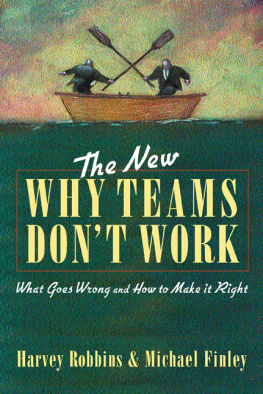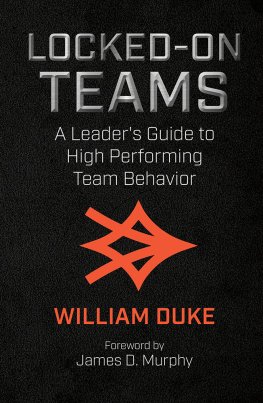

Copyright 2000 by Kimball Fisher. All rights reserved. Except as permitted under the United States Copyright Act of 1976, no part of this publication may be reproduced or distributed in any form or by any means, or stored in a database or retrieval system, without the prior written permission of the publisher.
ISBN: 978-0-07-136785-1
MHID: 0-07-136785-3
The material in this eBook also appears in the print version of this title: ISBN: 978-0-07-134924-6, MHID: 0-07-134924-3.
All trademarks are trademarks of their respective owners. Rather than put a trademark symbol after every occurrence of a trademarked name, we use names in an editorial fashion only, and to the benefit of the trademark owner, with no intention of infringement of the trademark. Where such designations appear in this book, they have been printed with initial caps.
McGraw-Hill eBooks are available at special quantity discounts to use as premiums and sales promotions, or for use in corporate training programs. To contact a representative please e-mail us at bulksales@mcgraw-hill.com.
This publication is designed to provide accurate and authoritative information in regard to the subject matter covered. It is sold with the understanding that the publisher is not engaged in rendering legal, accounting, or other professional service. If legal advice or other expert assistance is required, the services of a competent professional person should be sought.
From a declaration of principles jointly adopted by a committee of the American ar Association and a committee of publishers.
TERMS OF USE
This is a copyrighted work and The McGraw-Hill Companies, Inc. (McGraw-Hill) and its licensors reserve all rights in and to the work. Use of this work is subject to these terms. Except as permitted under the Copyright Act of 1976 and the right to store and retrieve one copy of the work, you may not decompile, disassemble, reverse engineer, reproduce, modify, create derivative works based upon, transmit, distribute, disseminate, sell, publish or sublicense the work or any part of it without McGraw-Hills prior consent. You may use the work for your own noncommercial and personal use; any other use of the work is strictly prohibited. Your right to use the work may be terminated if you fail to comply with these terms.
THE WORK IS PROVIDED AS IS. McGRAW-HILL AND ITS LICENSORS MAKE NO GUARANTEES OR WARRANTIES AS TO THE ACCURACY, ADEQUACY OR COMPLETENESS OF OR RESULTS TO BE OBTAINED FROM USING THE WORK, INCLUDING ANY INFORMATION THAT CAN BE ACCESSED THROUGH THE WORK VIA HYPERLINK OR OTHERWISE, AND EXPRESSLY DISCLAIM ANY WARRANTY, EXPRESS OR IMPLIED, INCLUDING BUT NOT LIMITED TO IMPLIED WARRANTIES OF MERCHANTABILITY OR FITNESS FOR A PARTICULAR PURPOSE. McGraw-Hill and its licensors do not warrant or guarantee that the functions contained in the work will meet your requirements or that its operation will be uninterrupted or error free. Neither McGraw-Hill nor its licensors shall be liable to you or anyone else for any inaccuracy, error or omission, regardless of cause, in the work or for any damages resulting therefrom. McGraw-Hill has no responsibility for the content of any information accessed through the work. Under no circumstances shall McGraw-Hill and/or its licensors be liable for any indirect, incidental, special, punitive, consequential or similar damages that result from the use of or inability to use the work, even if any of them has been advised of the possibility of such damages. This limitation of liability shall apply to any claim or cause whatsoever whether such claim or cause arises in contract, tort or otherwise.
I rededicate this book to Reenie,
My wife, my colleague, and my best friend
Dont mourn what you arent, celebrate what you are.
Mareen Fisher
Contents
A NEW KIND OF LEADER FOR A NEW KIND OF BUSINESS ENVIRONMENT
BUILDING THE FOUNDATION FOR CHANGE
THE POWER OF VALUES AND ASSUMPTIONS
THE ROLE OF THE TEAM LEADER
THE TEAM LEADER WORKOUT
COMMON PROBLEMS AND UNCOMMON SOLUTIONS
TEAM LEADER EVALUATION TOOLS
Foreword
EMPOWERMENT AND TEAMS have taken the world by storm. Managers have found that remaining competitive means tapping into the vast, underutilized resource of knowledge within their workforces. Furthermore, customer responsiveness requires greater integration across functional groups. Cross-functional teams have thus become commonplace as organizations strive for reduced product-to-market times and continuous improvement throughout the value chain. But making teams function effectively has remained an elusive dream for many organizations.
Modern business culture, to a great extent built on individualism and a diversity of interests, runs counter to teams. Teamwork requires pulling a group of diverse individuals together to work toward a common goal. Some managers take the term self-management literally and expect teamwork to happen somehow by magic. But teamwork does not just emerge. It requires strong leadership throughout the entire organization.
Managers at several new plant start-ups believed they could run their operations without supervisors or first-level managers, only to find they needed to add back that level of management as their operations failed to perform. A manager at one plant where first-level supervisors were eliminated noted that things ran fairly smoothly four out of five days a week but that the plant could really use supervision on that fifth day. However, the manager was afraid to reinstitute a leadership role because he did not know how to keep team leaders from reverting back to acting as traditional supervisors.
For years, organizational consultants have used the terms coach, trainer, facilitator, and resource to describe the leadership role. Coach and trainer are at least fairly familiar words, but facilitator and resource often sound like terms from another world. They are ambiguous. Worse yet, the role evolves as teams mature. Making sense out of this new environment is far from easy. Much confusion still exists as to what the role of team leadership is all about.
Kimball Fisher helps to elevate us out of the jargon with real-world examples and tips to make the transition. He has seen what works and what doesnt from firsthand observationboth as a team leader in a successful self-directed team operation and as a consultant helping organizations transform themselves from traditional to empowered work systems. He is thus able to provide a roadmap showing how organizations can create an environment that promotes the development of team leaders.
But as Kimball rightly stresses, it is insufficient to merely develop leaders at the first level of management. Leadership must occur at every level of the organization, including the top executive suite. And as difficult as the task of changing to team leadership may seem at the first level of management, at the middle management and executive levels it is even harder. Fortunately, Kimball provides a vision for how to make the journey.
Janice Klein
Gloucester, MA
Jan Klein has taught operations management at the Harvard Business School and MITs Sloan School of Management. Over the past decade, she has been studying the changing role of managers and supervisors in organizations.
Next page









